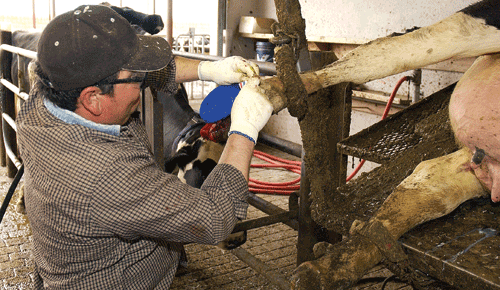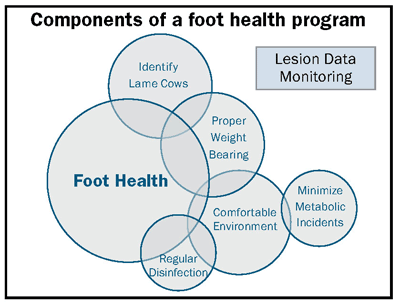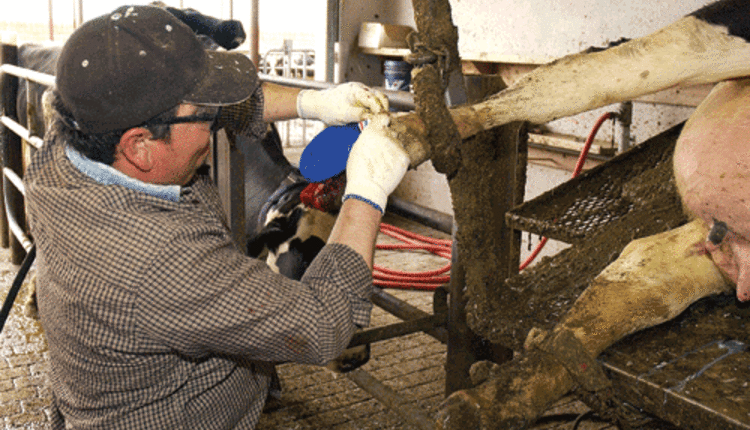The author is owner of the Cramer Mobile Bovine Veterinary Services, Stratford, Ontario, Canada

Your nutritionist isn't to blame for your hoof health problems.
Use a prevention plus treatment system to improve your herd's mobility
It is well known that lameness is a common, painful, costly disease and a major animal welfare concern. Fortunately, knowledge exists to prevent and reduce its impact.
Six steps for good "steps"
The six components outlined below can be thought of as the six success factors that, when maximized, will prevent lameness due to digital dermatitis, sole ulcers and white line disease. The specific details for your program should be developed in conjunction with the professionals (veterinarians, hoof trimmers, nutritionists and so forth) familiar with your herd.

1. Monitoring and using lesion data.
The basis for developing a farm-specific foot health program comes from the foot lesion data of clinically lame cows. This foot lesion data, when combined with parity and stage of lactation, allows prevention programs to be tailored to your farm instead of being created for the average operation. Continued recording of foot lesion data allows for the monitoring and adjustment of the foot heath program as farm dynamics evolve.
Data recording starts with the person doing the hoof trimming. This professionally trained person should record lesions in a standardized manner to allow proper communication between the hoof trimmer and the farm's advisory team. This process does not have to be complicated.
At minimum, it is necessary to record the cow's name or ID, date, lesion and treatment applied. Additional data on location and severity of the lesion is of lesser value from a monitoring perspective and should not become an impediment to recording the necessary basic information. Regardless of recording method, it is necessary that this data is combined with on-farm management software to allow both cow and herd-level decisions to be made.
2. Identify and treat lame cows early.
The most important part of a foot health program is to create a system for early detection of lame cows and standardized treatment protocols. The primary reason to focus on the detection and treatment of lameness is to improve the well-being of the cow.
Too often lameness is treated as a nonurgent disease, and we take a wait-and-see approach. Since lameness quickly develops into a chronic disease, early intervention will result in a reduced duration of pain, a quicker return to productivity and a reduced chance of chronicity.
3. Focus on a comfortable environment.
Facilities that minimize standing time and exposure to manure is important in preventing sole ulcers, white line disease and digital dermatitis. You should focus on creating a comfortable environment for cows to stand and lie down. It should be clean and dry in all traffic areas.
In a free stall, manure and wetness are a fact of life. But, exposure can be reduced by proper drainage and avoiding puddles in all traffic areas. Other keys to creating clean feet are the timing and frequency of alley cleaning and nonlactating cow housing hygiene.
Any change that reduces standing time is going to result in fewer sole ulcers as it removes weight bearing from the horn-producing tissue. A deep-bedded stall is a great start to reducing standing time, but the focus on cow comfort needs to go beyond stall design. Analyze your herd's time budget to discover areas of avoidable standing time. Initial areas to focus on include time away from stalls and feed and time spend in lockups for management procedures.
4. Regular disinfection of feet.
Once the cleanliness of cows' feet has been addressed, the reality is most herds still require the regular use of a properly sized footbath to clean and disinfect feet. There are few clinical studies to prove the efficacy and economics of most current footbath products, but almost any product can be effective when used frequently in an appropriately sized footbath.
A good footbath protocol starts with thinking of footbathing as prevention, similar to teat dipping, and not as a treatment tool. As a preventative tool, the goal of footbathing should be to either clean or disinfect feet.
Recent work has shown that creating a footbath that is at least 10 feet long along with more frequent use improves digital dermatitis control. Furthermore, footbathing with only water has been shown to reduce digital dermatitis. Thus, there are good reasons for a cow to go through a properly designed footbath daily containing either an antiseptic or water.
5. Properly balanced weight bearing.
Hoof trimming plays an important preventative role in maintaining foot health. In most of our current housing environments, an imbalance is created between horn growth and wear. Within a foot health program, the goal of hoof trimming is to treat and prevent lameness. Therefore, any horn removed from a cow's foot should meet that goal. Preventative hoof trimming attempts to remove the excessive growth and redistribute the forces that occur within a cow's foot to avoid excessive pressure on the sole ulcer location.
Both on-farm and professional hoof trimmers need to be trained in proper hoof trimming technique and be periodically re-evaluated to ensure proper technique is being followed.
6. Minimize metabolic incidents.
The exact role of metabolic incidents and their relationship to lameness is still unclear. However, there is mounting evidence that what occurs in the transition period has a big effect on lameness. Factors such as time spent standing and amount of fat mobilization that occurs during the transition period are key areas to focus on.
Think beyond the ration
Traditionally, nutritional factors and nutritionists have received a lot of the blame for our herds' lameness problems. Rather than focusing on the paper ration and specific nutrient levels, the focus should be on factors that affect intake patterns such as usable bunk space, forage quality and consistency, timing of ration delivery and other behavioral factors. Changes in intake patterns have the potential to disrupt a cow's metabolic status and, when combined with an environment that lengthens her standing time, this can lead to lameness.
The knowledge exists to prevent lameness from becoming a major animal welfare issue. However, the implementation of this knowledge requires a concerted effort to develop farm-specific foot health programs. The keys of this program are to detect and treat lame cows early; focus on clean, dry and comfortable feet that are regularly disinfected and evaluated; and ensure metabolic incidents are minimized.
Click here to return to the Animal Care E-Sources
130310_154

Use a prevention plus treatment system to improve your herd's mobility
It is well known that lameness is a common, painful, costly disease and a major animal welfare concern. Fortunately, knowledge exists to prevent and reduce its impact.
Six steps for good "steps"
The six components outlined below can be thought of as the six success factors that, when maximized, will prevent lameness due to digital dermatitis, sole ulcers and white line disease. The specific details for your program should be developed in conjunction with the professionals (veterinarians, hoof trimmers, nutritionists and so forth) familiar with your herd.

1. Monitoring and using lesion data.
The basis for developing a farm-specific foot health program comes from the foot lesion data of clinically lame cows. This foot lesion data, when combined with parity and stage of lactation, allows prevention programs to be tailored to your farm instead of being created for the average operation. Continued recording of foot lesion data allows for the monitoring and adjustment of the foot heath program as farm dynamics evolve.
Data recording starts with the person doing the hoof trimming. This professionally trained person should record lesions in a standardized manner to allow proper communication between the hoof trimmer and the farm's advisory team. This process does not have to be complicated.
At minimum, it is necessary to record the cow's name or ID, date, lesion and treatment applied. Additional data on location and severity of the lesion is of lesser value from a monitoring perspective and should not become an impediment to recording the necessary basic information. Regardless of recording method, it is necessary that this data is combined with on-farm management software to allow both cow and herd-level decisions to be made.
2. Identify and treat lame cows early.
The most important part of a foot health program is to create a system for early detection of lame cows and standardized treatment protocols. The primary reason to focus on the detection and treatment of lameness is to improve the well-being of the cow.
Too often lameness is treated as a nonurgent disease, and we take a wait-and-see approach. Since lameness quickly develops into a chronic disease, early intervention will result in a reduced duration of pain, a quicker return to productivity and a reduced chance of chronicity.
3. Focus on a comfortable environment.
Facilities that minimize standing time and exposure to manure is important in preventing sole ulcers, white line disease and digital dermatitis. You should focus on creating a comfortable environment for cows to stand and lie down. It should be clean and dry in all traffic areas.
In a free stall, manure and wetness are a fact of life. But, exposure can be reduced by proper drainage and avoiding puddles in all traffic areas. Other keys to creating clean feet are the timing and frequency of alley cleaning and nonlactating cow housing hygiene.
Any change that reduces standing time is going to result in fewer sole ulcers as it removes weight bearing from the horn-producing tissue. A deep-bedded stall is a great start to reducing standing time, but the focus on cow comfort needs to go beyond stall design. Analyze your herd's time budget to discover areas of avoidable standing time. Initial areas to focus on include time away from stalls and feed and time spend in lockups for management procedures.
4. Regular disinfection of feet.
Once the cleanliness of cows' feet has been addressed, the reality is most herds still require the regular use of a properly sized footbath to clean and disinfect feet. There are few clinical studies to prove the efficacy and economics of most current footbath products, but almost any product can be effective when used frequently in an appropriately sized footbath.
A good footbath protocol starts with thinking of footbathing as prevention, similar to teat dipping, and not as a treatment tool. As a preventative tool, the goal of footbathing should be to either clean or disinfect feet.
Recent work has shown that creating a footbath that is at least 10 feet long along with more frequent use improves digital dermatitis control. Furthermore, footbathing with only water has been shown to reduce digital dermatitis. Thus, there are good reasons for a cow to go through a properly designed footbath daily containing either an antiseptic or water.
5. Properly balanced weight bearing.
Hoof trimming plays an important preventative role in maintaining foot health. In most of our current housing environments, an imbalance is created between horn growth and wear. Within a foot health program, the goal of hoof trimming is to treat and prevent lameness. Therefore, any horn removed from a cow's foot should meet that goal. Preventative hoof trimming attempts to remove the excessive growth and redistribute the forces that occur within a cow's foot to avoid excessive pressure on the sole ulcer location.
Both on-farm and professional hoof trimmers need to be trained in proper hoof trimming technique and be periodically re-evaluated to ensure proper technique is being followed.
6. Minimize metabolic incidents.
The exact role of metabolic incidents and their relationship to lameness is still unclear. However, there is mounting evidence that what occurs in the transition period has a big effect on lameness. Factors such as time spent standing and amount of fat mobilization that occurs during the transition period are key areas to focus on.
Think beyond the ration
Traditionally, nutritional factors and nutritionists have received a lot of the blame for our herds' lameness problems. Rather than focusing on the paper ration and specific nutrient levels, the focus should be on factors that affect intake patterns such as usable bunk space, forage quality and consistency, timing of ration delivery and other behavioral factors. Changes in intake patterns have the potential to disrupt a cow's metabolic status and, when combined with an environment that lengthens her standing time, this can lead to lameness.
The knowledge exists to prevent lameness from becoming a major animal welfare issue. However, the implementation of this knowledge requires a concerted effort to develop farm-specific foot health programs. The keys of this program are to detect and treat lame cows early; focus on clean, dry and comfortable feet that are regularly disinfected and evaluated; and ensure metabolic incidents are minimized.
130310_154









